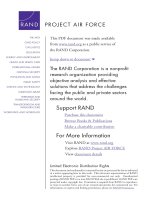Current status and diversity of Ophidians (Reptilia: Squamata: Serpents) in Bhopal, Madhya Pradesh, Central India
Bạn đang xem bản rút gọn của tài liệu. Xem và tải ngay bản đầy đủ của tài liệu tại đây (369.67 KB, 7 trang )
Int.J.Curr.Microbiol.App.Sci (2017) 6(5): 1384-1390
International Journal of Current Microbiology and Applied Sciences
ISSN: 2319-7706 Volume 6 Number 5 (2017) pp. 1384-1390
Journal homepage:
Original Research Article
/>
Current Status and Diversity of Ophidians (Reptilia: Squamata: Serpents) in
Bhopal, Madhya Pradesh, Central India
Amit Manhas1*, Rajni Raina2 and Ashwani Wanganeo1
1
Department of Environmental Sciences and Limnology, Barkatullah University Bhopal,
Madhya Pradesh, India
2
Department of Zoology, Government Science and Commerce (Benazir) College,
Bhopal, Madhya Pradesh, India
*Corresponding author
ABSTRACT
Keywords
Diversity,
Ophidians,
Status and Bhopal.
Article Info
Accepted:
12 April 2017
Available Online:
10 May 2017
A survey was conducted on the status and diversity of ophidians of Bhopal between
November 2015 and September 2016. Seventeen species of snakes belonging to 17 genera
and 06 families (Boidae, Colubridae, Elapidae, Pythonidae, Typhlopidae and Viperidae)
were recorded during this study period. Family colubridae contributed the maximum (08
species) number of species whereas family Typhlopidae contribute minimum (1 species).
Ptyas mucosa and Xenochrophis piscator was found common among non-venomous
snakes while the rarest was Dendrelaphis tristis and Lycodon aulicus belonging to the
family Colubridae. Among venomous snakes Naja naja was observed common where
Echis carinatus was found rare in present study. Mortality due to vehicular killings and
with the hands of human was observed to be the main threat in the area. Although some of
the species are well scheduled in wild life protection act 1972 still peoples are unaware
about the protocols given. Thus we suggest awareness programs should be organized to
aware local residents about the ecology and importance of these species in an ecosystem.
Introduction
Snakes are the most fearer group of reptiles in
world since their appearance but the
majorities of them are non-venomous and are
valuable to both humans and ecosystem. They
are known to be friends of farmers besides
helpful in maintaining the ecological
equilibrium. Snakes inhibited all over the
world except some very cold regions like the
Arctic Region. There are about 3,619 species
of snakes were in records under 26 families
all over the world (Uetz and Hošek, 2016).
While in India about 279 species of snakes
comprising of 28 families have been recorded
so far (Aengals et al., 2011). Though
researchers had studied and documented
snakes from different parts of the state but
still snakes of Madhya Pradesh are poorly
known especially from Bhopal. Nineteen
species of snakes were reported by Pasha et
al., (2000) from Pench National Park. Ingle
(2002) enlisted 30 species of snakes from
Malwa region of Madhya Pradesh. Chandra
1384
Int.J.Curr.Microbiol.App.Sci (2017) 6(5): 1384-1390
and Gajbe (2003) had recorded ocellate shield
tail snake (Uropeltis Ocellate) from
Pachmarhi Biosphere Reserve. Chandra and
Gajbe (2005) compiled a list of 39species of
snakes which belonged to 06 families from
different parts of the state Madhya Pradesh.
Chandra (2009) had documented 08 species
of snake’s belonging to 06 families from
Pachmarhi biosphere reserve. Pragatheesh and
Rajvanshi (2013) studied the road mortality of
snakes at Nation highway -7 along the Pench
National park of Madhya Pradesh and
recorded 490 such incidents. Dubey and
Khare, (2013) reported 12 species of reptiles
which belongs to 16 families from Chhatarpur
District, Madhya Pradesh. Around 31 species
of snakes under 06 families (Boidae,
Colubridae,
Elapidae,
Typhlopidea,
Uropeltidae and Viperidae) have been
compiled from Satpura Tiger reserve and
Panchmarhi Biosphere (Fellows, 2015). In
Bhopal very little attention has been given to
studies related to ophidians. Manhas et al.,
(2015) while working on diversity of
herpetofauna documented 7 species of snakes
from inside the campus Barkatullah
University, Bhopal. While Manhas et al.,
(2015) has enlisted 17 species of snakes from
Bhopal region Whereas, 11 species of snakes
from Barkatullah University were recorded by
Manhas et al., (2016).
However no systematic study on the status of
ophidians of Bhopal region is on record, so an
effort was made to provide current status of
these serpents with their comprehensive list.
Shyamalahills in the northern region, Katara
hills in south region and Arera hills in the
central region. The climate here is humid
subtropical with hot summer and a humid
monsoon season where summers start in late
March and go on till mid-June, the average
temperature during which remains around
30°C (86 °F), with the peak of summer in
May, when it regularly exceed 40°C (104 °F)
while monsoon starts in late June and ends in
late September.
Materials and Methods
The study was conducted in Bhopal between
November 2015 and September 2016. The
study on live snake specimens was carried out
during the study period to know presence and
their current status in Bhopal. No specimen
was harmed during the study. Field
observations were done all over day but
importance was given to morning and night
observations when snakes are more active
than other times, to sight the snakes. Results
of some opportunistic sightings of snakes
have also been incorporated in the list. The
whole study area was thoroughly surveyed
following visual encounter survey. The
snakes that were observed more than 20 times
considered very common and are denoted as
“VC”, common (C) which were sighted 15–
20times, fairly common (FC) were sighted 5–
15 times and rare (R) which were observed 1–
5 times. The specimens were identified on the
basis of literature documented earlier and
field guide books (Smith, 1943; Daniels, 2002
and Whitaker and Captain, 2004).
Study area
Results and Discussion
The present investigation was carried out in
Bhopal region, the capital of the Madhya
Pradesh state, central India (Figure 1). It is
geographical located at latitude 23° 14' 01''N
and longitude 77° 23' 36''E having an average
elevation of 527 masl (1,729 ft.). The region
has irregular elevation and small hills within
its restrictions viz., Idgah hills and
Seventeen species of snakes (Table 1)
belonging 06 families were sighted from
Bhopal during the present investigation.
Among them, 01 species (06%) belong to the
family Typhlopidae, 01 species (6%) of
Pythonidae, 08 species (47%) of Colubridae,
03 species (17%) of Elapidae and 02 species
1385
Int.J.Curr.Microbiol.App.Sci (2017) 6(5): 1384-1390
(12%) of Viperidae and 02 species (12%) of
Boidae (Figure 2). Out of all 17 species
enlisted 05 species (Python molurus, Ptyas
mucosa, Xenochrophis piscator, Naja naja,
Ophiophagus hannah and Daboia russelii) of
snakes under 04 family were protected under
Sch II (Part II) whereas other 12 species were
under Sch IV of Indian Wildlife Protection
act, 1972 are presented in table 1.
The total recorded species from present study
area contributes 43.58% of snakes compared
to the Madhya Pradesh (39 species: Chandra
and Gajbe, 2005), 6.09% snakes of India (279
species: Aengals et al., 2011) and 0.53% of
World (3169 species: Uetz & Hošek, 2016).
Four species (24%) of snakes are very
common (VC), six species (35%) are common
(C), two species (12%) are fairly common
(FC), and five species (29%) were observed
rare (R) in Bhopal region (Figure 3). Overall,
Checkered Keelback (Xenochrophis piscator)
followed by Ptyas mucosa were observed the
most common and Lycodon aulicus followed
by Dendrelaphis tristis was rarest.
Five venomous species of snakesobserved in
Bhopal region out of which 03 species falls
under three genera (Bungarus, Naja and
Ophiophagus) belonging to the family
Elapidae and two species (Daboia russelii and
Echis carinatus) under family Viperidae. The
species Ophiophagus hannah was observed at
Van Vihar national park Bhopal. Among the
venomous species of snakes Spectacled Cobra
(Naja naja) was found common whereas
Echis carinatus was observed rare in current
study.
Fig.1 Bhopal region (MP)
1386
Int.J.Curr.Microbiol.App.Sci (2017) 6(5): 1384-1390
1387
Int.J.Curr.Microbiol.App.Sci (2017) 6(5): 1384-1390
Table.1 List of snakes observed in Bhopal (MP) along with their status
(Local, WPA 1972 and IUCN 2016) India
S.No Family
Scientific name
Common name
1
2
3
Eryx conicus
Eryx johnii
Python molurus
Common Sand Boa
Red Sand Boa
Indian rock Python
4
Amphiesma stolata
5
Argyrogene
fasciolatus
Coelognathus
helena
Lycodon aulicus
Buff-Striped
Keelback
Banded Racer
Boidae
Pythonidae
6
7
8
Colubridae
Dendrelaphis tristis
Status
Schedule in
(Bhopal) Protection
act, 1972
C
Sch IV
R
Sch IV
R
Sch I (Part
II)
C
Sch IV
IUCN
Status
C
Sch IV
NE
Common trinket
FC
Sch IV
NE
Common
Wolf
Snake
Common
Bronze
Back
Banded Kukri Snake
Indian Rat snake
R
Sch IV
NE
R
Sch IV
NE
C
VC
Sch IV
NE
Sch II (Part NE
II)
Sch II (Part NE
II
Sch IV
NE
9
10
Oligodon amensis
Ptyas mucosa
11
Xenochrophis
Checkered Keelback VC
piscator
Water Snake
Bungarus caeruleus Common
Indian C
Krait
Naja naja
Spectacled Cobra
VC
12
13
14
15
16
17
Elapidae
Ophiophagus
hannah
Typhlopidae Ramphotyphlops
braminus
Viperidae
Daboia russelii
King Cobra
----
Brahminy
Worm FC
snake
Russell′s Viper
C
Echis carinatus
NE
Sch II (Part NE
II)
Sch II (Part VU
II)
Sch IV
NE
Sch II (Part NE
II)
Sch IV
NE
Indian
saw-scaled R
Viper
Note: VC =Very common; FC= fairly Common; C=Common; R=Rare; NE= Not Evaluated
1388
NE
NE
NE
Int.J.Curr.Microbiol.App.Sci (2017) 6(5): 1384-1390
Out of the all species sighted, 03 species
(Ptyas mucosa, Xenochrophis piscator and
Amphiesma stolata) were observed to have
semi-aquatic behavior whereas 05 species
including
Argyrogene
fasciolatus,
Coelognathus helena, Dendrelaphis tristis
and Ptyas mucosa) was observed to have
semi-arboreal and 02 species (Eryx conicus
and Eryx johnii) semi-fossorial activities.
Eight species of snakes were observed to be
completely terrestrial in Bhopal region. Many
species of snakes die due to vehicular
movements mostly during the peak months of
the year. During this investigation the species
sighting was observed maximum in monsoon
months (From Mid-June to Mid-September).
Before theses months snakes were in active or
been in aestivation as no species was sighted
before monsoon. Because snakes are ectothermic animals and they require optimum
heat to do their daily activities and in this
region the summers receive very high
temperature fluctuations whereas after
monsoon the activity slows down up to midNovember thereafter the activities of these
creatures stop completely till favorable
climatic conditions. The mortality of snakes
because of vehicular passage threatened snake
species in this region of the state mostly
during monsoons (Manhas et al., 2015).
Further investigations are required to be
conducted to know the comprehensive
ecology of the snakes that are residing in this
portion of the country viz., Bhopal (MP). The
habitat is being degraded due the destroying
forests. In urban localities the species was
being killed mainly because of the fear and
unawareness between locals.
Furthermore, human created appliances and
their settlements near forest trail and
agricultural practices are also a reason for the
destruction of the habitat of snakes. Thus all
these reason are causing unsustainable
diversity of snake species, so there is an
urgent need of minimizing these tribulations
for future better improvement of snake
diversity in Bhopal.
References
Chandra, K. 2009. Fauna of Pachmarhi
Biosphere Reserve, Conservation Area
Series, 39: 117-128.
Chandra, K. and Gajbe, U.P. 2003. New
record of Ocellate shield tail Uropeltis
ocellata, Beddome),. Uropeltidae) from
Pachmarhi Biosphere reserve, Madhya
Pradesh, Cobra, 52:15-16.
Chandra, K. and Gajbe, U.P. 2005. An
inventory of Herpetofauna of Madhya
Pradesh and Chhattisgarh. Zoos’ Prints
J., 20(3): 1812-1819.
Daniel, J.C. 2002.The book of Indian Reptiles
and Amphibians. Oxford University
Press, New Delhi.
Dubey, A. and Khare, N. 2013. Reptile fauna
of Chhatarpur district Madhya Pradesh,
India. World J. Sci., 1(2): 133-144.
Fellows, S. 2015. Species Diversity of Snakes
in Pachmarhi Biosphere Reserve. Ento.
Ornitho.
Herpeto.,
4:
136.
/>lines/schedule_species_reptiles.pdf.
Assessed on 22 March, 2017.
Ingle, M. 2002. Ecology and status of the
ophiofauna of eight districts of Malwa
region of Madhya Pradesh. Cobra, 50:
1-17.
Manhas, A., Kotwal, A., Wanganeo, R.R.,
Wanganeo, A. 2015. Diversity, Threats
and Conservation of Herpetofauna in
and around Barkatullah University,
Bhopal. MP), India. Int. J. Adv. Res.,
3(9): 1546-1553.
Manhas, A., Raina, R., and Wanganeo, A.
2015. Snakes of the Bhopal district,
Madhya Pradesh, India with special
reference to road mortality. J. Res.
Biol., 5(7): 1868-1873.
1389
Int.J.Curr.Microbiol.App.Sci (2017) 6(5): 1384-1390
Manhas, A., Raina, R., and Wanganeo, A.,
2016. An addition to the reptilian
diversity of Barkatullah University
campus, Bhopal, Madhya Pradesh,
India. Int. J. Pure Appl. Zool., 4(4):
306-309.
Pasha, M.K.S., Areendran, G., Sankar, K. and
Qureshi, Q. 2000. A preliminary
checklist of snakes of Pench Tiger
Reserve, Madhya Pradesh. Cobra, 40:
5-8.
Pragatheesh, A. and Rajvanshi, A. 2013.
Spatial patterns and factors influencing
the mortality of snakes on the national
highway-7 along Pench Tiger reserve,
Madhya Pradesh, India. Oecologia
Australis, 17(1): 20–35.
Smith, M.A. 1943. Fauna of British India,
Vol. III: Serpentes, Published by Taylor
and Francis, London.
Uetz, P. & J. Hošek. eds. 2016. The Reptile
Database.
Available
at
Accessed on 15
November 2016.
Whitaker, R. and Captain, A. 2004. Snakes of
India-The field guide, Draco Books,
Chennai, India.
How to cite this article:
Amit Manhas, Rajni Raina and Ashwani Wanganeo. 2017. Current status and Diversity of
Ophidians (Reptilia: Squamata: Serpents) in Bhopal, Madhya Pradesh, central India.
Int.J.Curr.Microbiol.App.Sci. 6(5): 1384-1390. doi: />
1390









